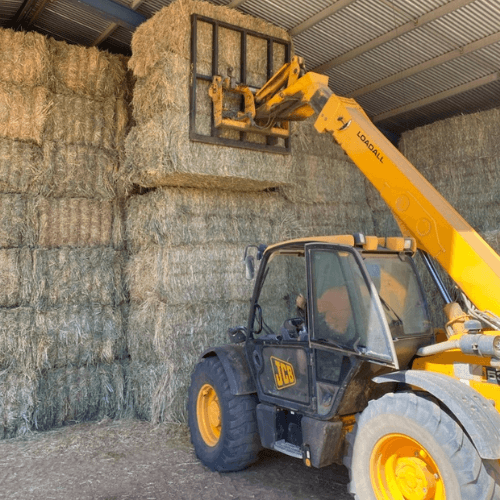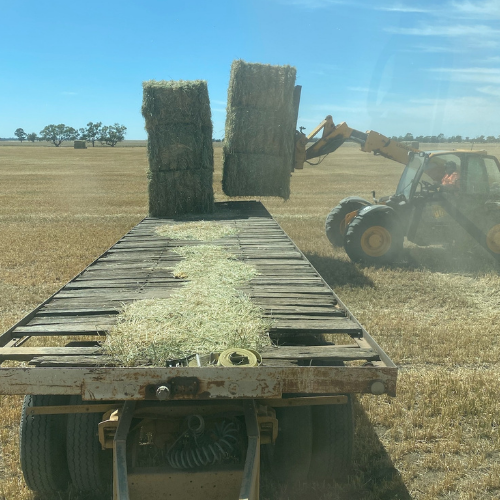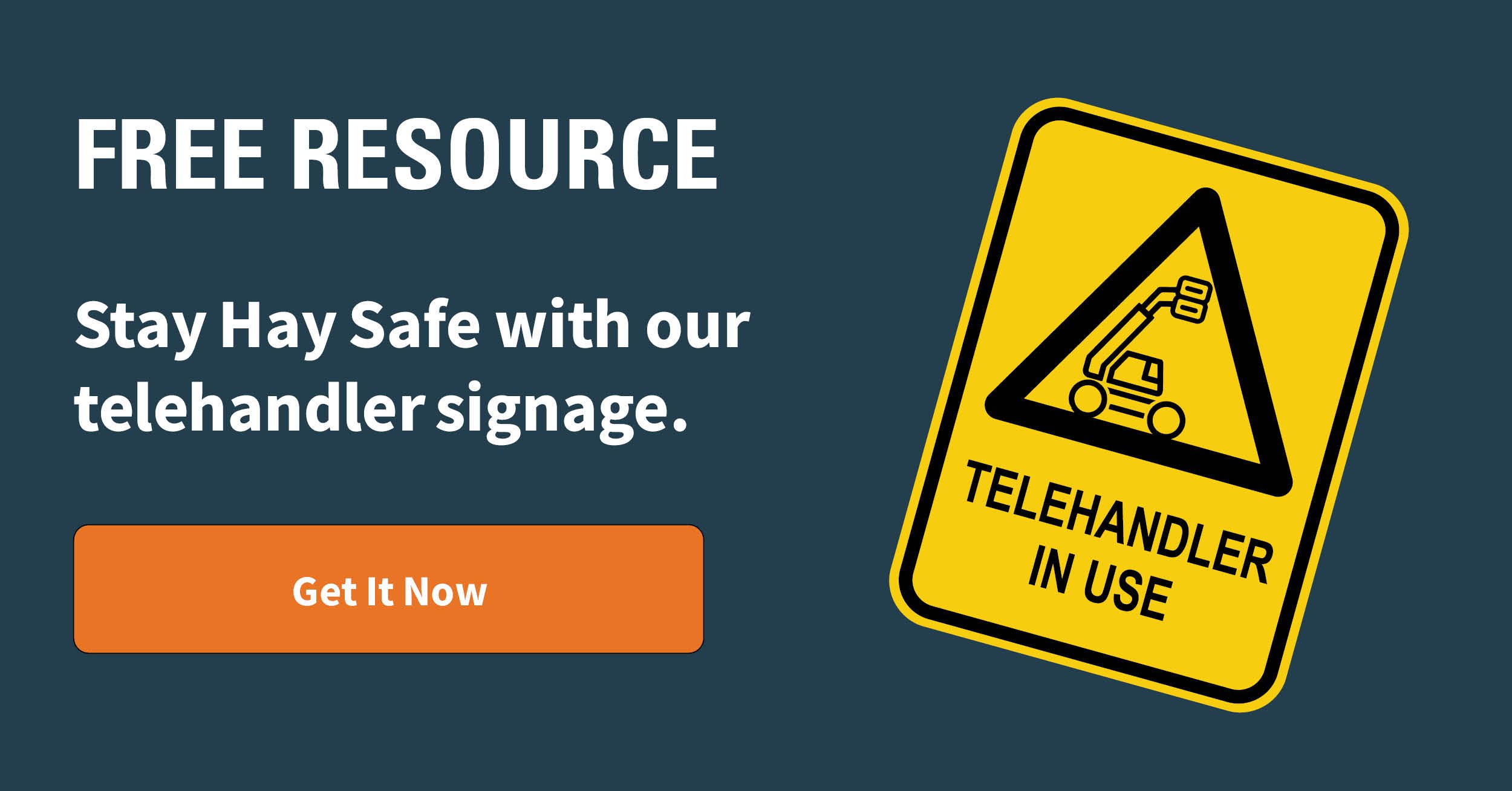Grab our comprehensive 20+ page guide that highlights the major risks and hazards associated with your farm machinery.
For generations, tractors have been the backbone of farm operations, holding a special significance in agriculture.
Tractors have long been trusted to handle a wide range of manual tasks. However, advances in technology have seen the telehandler emerge as the new workhorse. These machines offer greater efficiency and versatility to meet the evolving needs of modern farms, however, operating one still comes with significant risk.
What is the role of telehandlers on farm?
There are a variety of reasons why we're seeing telehandlers replacing tractors. Their versatile attachments suit multiple tasks, such as moving feed, unloading pallets, and yes, stacking hay bales.
With these additional abilities, it's easy to see how productivity levels are on the rise. When compared to a forklift, telehandlers offer a high-load capacity, lifting heavier loads to greater heights over longer distances. Without having to change machines, workers get more done in less time.
Telehandlers are the ideal machine for tight spaces and uneven surfaces. Providing four-wheel drive capabilities, telehandlers are as comfortable off-road as they are on it with the right operator.
Did you know that telehandlers with a load capacity over three tonnes require a high-risk work license to operate?
Discover the top 5 Telehandler Hazards here!
What is a telehandler?
In case you’ve gotten this far without knowing exactly what a telehandler is. It's also known as a telescopic handler, variable reach truck or boom lift.
Not to be confused with a normal forklift, telehandlers are vehicles identifiable by their extendable boom that moves forwards and upwards. Modern telehandlers are designed to allow operators to easily change lifting attachments, enabling them to complete various tasks. Attachments can include hooks, winches, jibs, clamps and buckets.

Top 10 hazards of a telehandler
As a significant player in the fodder Industry, we’ve chosen to address the top 10 hazards associated with operating a telehandler, to keep you and your workers safe.
1. Overturning or Tipping
Telehandlers are subject to the laws of gravity, excessive loads, unsuitable terrain (sloping or unstable ground) and operator error are just a few ways overturning and tipping can happen. Overloading or an extended boom increases the likelihood of overturning. Keep the load low and close to the machine to maintain stability. Level your machine by means of the level indicator before raising any load.
2. Site conditions
Like most machinery, when operating a telehandler on unstable ground, it can be hazardous. Soft and uneven ground is associated with overturning, so before you operate a telehandler, review your site conditions and compare them to the operator's manual, consider your machine's limitations and Safe Work Procedure. The ground may require compacting so that stabilisers are in contact with a firm, stable surface. Ensure the stabiliser indicator lamp is on before using the boom.
3. Electrocution
Always assess the operating environment, ensuring you keep clear of live cables and overhead powerlines. Consider the vehicle's route as it moves around the farm, and check the minimum safe distance for electrical hazards. Operators and bystanders are at risk of electric shock if your telehandler were to come into proximity of live electrical hazards. Look at exclusion zones, barricades and consider a spotter.
4. Struck by a telehandler
Unfortunately, in farming, being struck by a moving vehicle is all too common, and a telehandler is no different. You need to be aware of blind spots and any workers, pedestrians or bystanders. Install well-placed mirrors, a reversing camera, utilise a spotter, ensure reversing alarms are fitted and limit access to your loading zone.
5. Falling material
Telehandler operators should always carry their load as low as possible without dragging it due to the risk of crushing the driver or other workers. Before lifting or moving a load, you should ensure it is balanced and secure. When moving, travel with the load 20 to 30cm from the ground and at no more than 5km/h.

6. Damaged machinery and attachments
As an owner of a telehandler, you need to ensure you have a system in place to maintain servicing requirements. It is an essential aspect of safe operations to perform maintenance checks and inspections, monitor and fix any damage or deterioration to your telehandler. Both your telehandler and attachments are to be maintained in line with the manufacturer’s instructions to keep them in safe working condition.
7. Unsafe work procedures
Your workers should have the appropriate license, the correct training and familiarisation with the machinery they are using. Did you know that High Risk Work Licenses are required in Australia when operating a telehandler with a load capacity of three tonnes? Always check the weight of the load before attempting to handle it and refer to load charts.
8. Work platforms
Telehandlers can be fitted with a range of attachments, including work platforms. These platforms are attached to the telehandler's boom to provide access when working at heights. You should never use a telehandler with a makeshift work platform; only use platforms that are directly fixed to the telehandler, not on the forks.
9. Incompatible attachments
Telehandler operators should use attachments that are fit-for-purpose. Refer to the telehandler manufacturer's guide when selecting attachments. Incompatible attachments can lead to unsecured loads. Plan for safe and effective use, match the attachment to the type and size of the load. Follow specified procedures when fitting or removing attachments. Use approved attachments only.
10. Unexpected movement
This type of hazard normally relates to swinging motion when you have a hook or jib attachment with a suspended load. Suspended loads and turning with loads is more likely to impact the stability of a telehandler; if your operator does not allow for this, the telehandler can be susceptible to overturning. Never start, stop or suddenly change direction at high speed.
Formal training and assessment by a qualified trainer is essential for telehandler use, the training should cover overturning and prevention. Display warning signs and speed limits where appropriate, create a traffic management plan and identify unsuitable areas on your site map.
What are some things to remember to safely use a telehandler?
-
Use approved attachments
-
Keep the load low and close to the machine
-
Look in the direction you are driving
-
Travel no more than 5km/h
-
Avoid operating on side slopes
-
Regularly service and perform maintenance checks on your machine
-
Evaluate the risks with a risk assessment
-
Follow Safe Work Procedures
Like any piece of farming machinery, when used correctly telehandlers can improve your farming operations with greater efficiency and could even result in a safer farm. If you are after more information regarding the Telehandlers, Farm Safety and you, QFF have compiled a comprehensive Safety Book.
Topics: Machinery Maintenance
Disclaimer: Content on this website may be of relevance to users outside of Australia, but content links and examples are specific to Australia. Please check with your local authority for your country and industry requirements.












